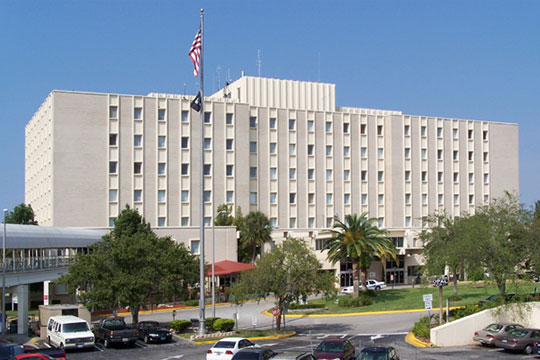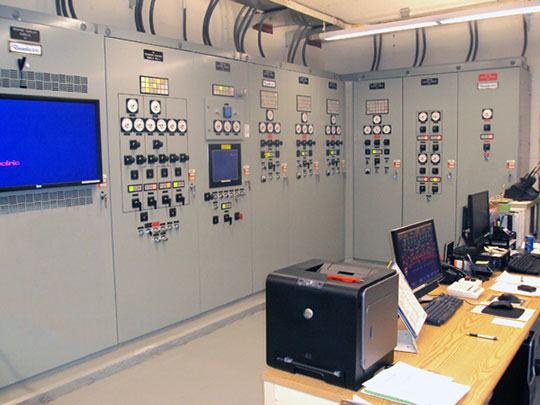| FM Strategies & Solutions from Building Operating Management |
 |
|||||
Emergency Power System |
 |
Byron Taylor, Haley’s Lead Power Plant Operator, says the new system provides many exciting capabilities and allows for future modifications.
“When storms come through, we no longer have to worry,” says Taylor. “One time, Tampa Electric (TECO) saw storms coming and asked us to drop off the grid. We fired up our generators, and operated on our own power for 17 hours, while TECO restored power to residential customers. This has happened several other times for shorter periods, and we’ve never had a problem.”
Comments Electrical Shop Supervisor Bill Hagen, “We get more blips from TECO than we do from our system. It’s exceptionally smooth.”
The old system’s nine on-site generators covered only life safety loads — 45% of the hospital’s total load — during a utility outage. “It was a major headache — we had nothing but problems with it,” Hagen recalls. “We never got it to work in parallel. It couldn’t even generate a monthly testing report.”
The new emergency system covers every load for nine buildings, the 15 trailers of an on-campus clinic, and a parking garage — with just seven new 13,200-VAC Caterpillar diesel generators that produce 2,200 kW each.
 |
Haley Veterans’ Hospital in Tampa, Florida, boasts one of the most
advanced |
The Power of Information
The new power control system also includes a Russelectric SCADA system, with software and screens customized to the hospital’s needs. It provides interactive monitoring, real-time and historical trending, distributed networking, alarm management, and comprehensive reports for the entire power system, not just the emergency system.
“The SCADA is so sensitive that it detects and explains even the slightest anomaly, including those in the utility feed,” says Taylor. “Several times we’ve called TECO because we saw something, before they even knew they had a problem! The system’s capabilities are phenomenal.”
 |
Russelectric control panels and custom SCADA system in |
Freedom to Test the System
Emergency generators are tested every month. With the system’s closed-transition transfer capability, these tests inconvenience no one. Because there is no “blip” (power interruption), there is no interference with hospital loads.
The system lets Taylor and Hagen perform testing in two ways. They can parallel the output of all seven generators to the utility feed, or they can test generators one at a time (up to full output) using a 2-MW load bank with independent controls. Testing can be initiated manually or through SCADA.
“We’ll never again have to pay a testing firm to test an engine to make sure it meets all the requirements,” says Hagen.
Unlike most hospitals, Haley has the luxury of four utility feeds. Normally, it draws from two of these. So, except for testing, Haley never has to start its generators until it loses three or more utility feeds.
At the utility’s request, Haley’s power plant can now parallel the utility feeds with its own generators, then switch seamlessly (closed-transition transfer) to on-site power. But an unexpected outage while testing the automatic transfer switches will cause a “blip” of 1-10 seconds. For life-safety and other critical loads, the “blip” is only 1-3 seconds. It is adjustable for other loads. Most are set for 8-10 seconds.
Technical Support
Taylor and Hagen have nothing but praise for Russelectric’s 24-hour support services after working hand-in-hand with Jim Bourgoin, Russelectric’s local Field Service Engineer, for seven months.
“During installation, Jim helped contractors interpret the design whenever they were puzzled,” Hagen says. “Afterwards, he stuck around to help us. I already had a background in this, but it took quite a bit of training to really get up to speed.”
Taylor recalls, “There has not been one time when I called Jim — whether at midnight or later — that he hasn’t answered the phone and helped me. On two occasions, he drove here at 3 or 4 in the morning to correct something that had gone wrong. But it’s not just his responsiveness that’s impressed us. He’s provided exceptional service since day one. To me, that’s worth as much as the system itself.”
For more information, contact: Russelectric,
800-225-5250 or (781) 749-6000, info@russelectric.com, www.russelectric.com.
Information courtesy of Russelectric |